Overview
The Minneapolis Institute of Arts represents early efforts to promote local art. This monumental building provides a focal point for the neighborhood.
- Location: 2400 3rd Avenue South
- Neighborhood: Whittier
The Minneapolis Institute of Arts represents early efforts to promote local art. This monumental building provides a focal point for the neighborhood.


The Minneapolis Institute of Arts represents early efforts to promote local art. This monumental building provides a focal point for the neighborhood. Its siting next to Washburn-Fair Oaks Park accentuates this effect.
In 1883, a small group of citizens founded the Minneapolis Society of Fine Arts. They sought to promote art in Minneapolis. At first they displayed art in the public library downtown. Then they built this museum in 1915.
The Society located their museum in the Whittier neighborhood. Wealthy residents were building homes around Washburn-Fair Oaks Park. Clinton Morrison donated his family's land for the museum.
The founders hired McKim, Mead, and White to design the original building. They were internationally known. This building is one of their few works in the upper Midwest. They clad this Neoclassical museum building in white Hardwick granite. A monumental front stairway leads to a two-story porch. Six fluted Greek columns support its roof. Pilastered wings flank the entrance. Two pedestals stood empty for decades. Now two lion statues from China rest there, guarding the museum entrance.
Over time the museum grew. Prominent architects designed new various additions. Master architect William Channing Whitney designed the Pillsbury Auditorium in 1926. In 1974 Japanese architect Kenzo Tange designed an east and west wing of white glazed brick. Walsh-Bishop designed another addition in 1991. Lastly, the Target Wing, built in 2006, was done by Michael Graves and Associates and RSP Architects.
True to its roots, the museum charges no admission to this day.
Historic Preservation
Phone
Address
Public Service Center
505 Fourth Ave. S., Room 320
Minneapolis, MN 55415